Choose the right varieties
The term “forcing” is an agricultural technique that allows you to deceive a plant and make it bloom at the wrong time. Small- and large-bulb crops are most likely to fall for this trick. However, the choice of variety is determined not by aesthetics, but by the planned flowering date.
For New Year or Christmas:
- Apricot Beauty;
- Christmas Marvel;
- Lustige Witwe;
- Brilliant Star;
- Fleming Flag.
For Valentine’s Day, Defender of the Fatherland Day and International Women’s Day:
- Presto;
- Scarborough;
- Diplomat;
- London;
- Oxford.
For May holidays:
- Golden Apeldoorn;
- Fringit Elegance;
- Burgundy Leys;
- Negrita;
- Hibernia.
There are a great many tulips suitable for autumn-winter forcing – these are just a few successful examples. The cycle from the beginning of the bulbs cooling until the long-awaited buds appear takes 12-16 weeks and depends on the specific variety, so growing flowers for any occasion will not be difficult.
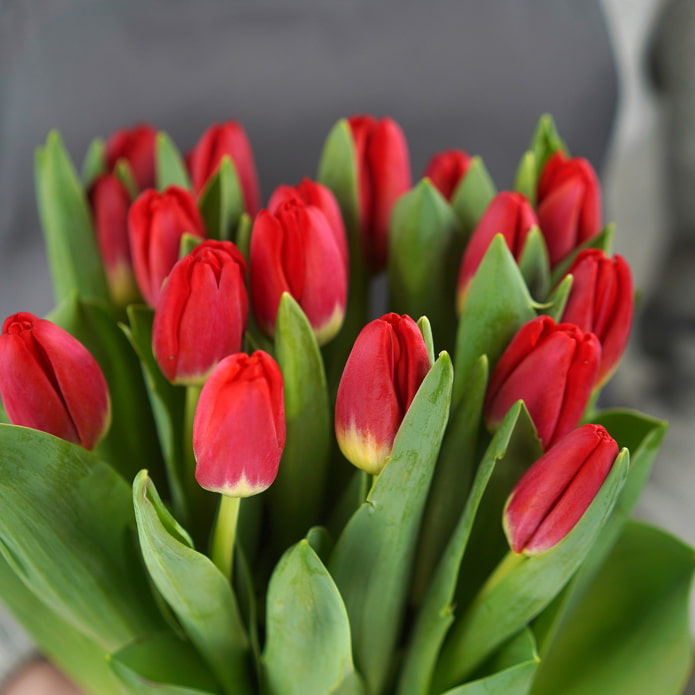
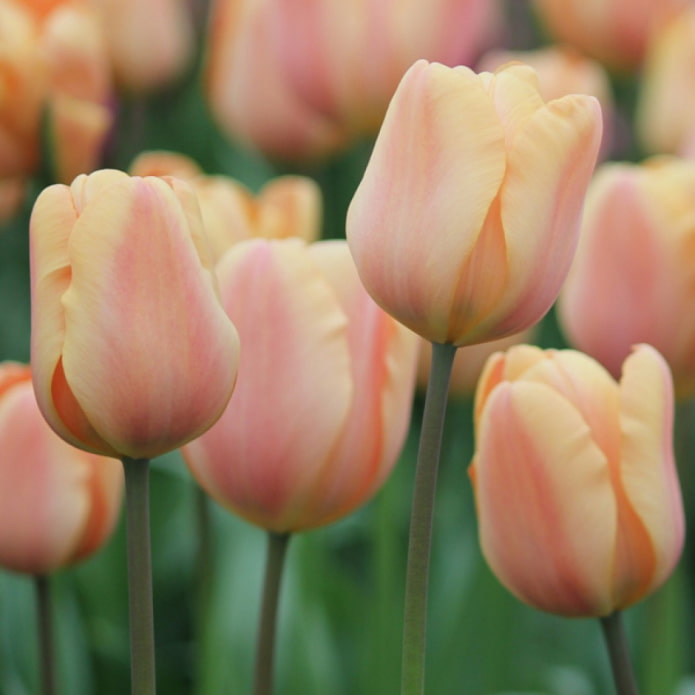
Carefully prepare the material
If you grow tulips in your garden and want to stock up on material for forcing yourself, do it right. Take a closer look at the flowerbed, mark the strongest plants and do not let them bloom by removing the elongated flower stalks in advance – this will save potential.
For cultivation in late autumn and winter, healthy strong bulbs at least 5 cm in diameter and no lighter than 25 grams are suitable.
Dry the dug out beauties as usual and send them for storage, and when the time comes for forcing, sort them, disinfect them with a fungicide and remove the upper scales so as not to interfere with the development of the root system and the free growth of shoots. The main condition for success is confidence in the impeccable health of the planting material.
You can save yourself the above-mentioned troubles by purchasing bulbs in a flower shop, where they will help you choose a variety, demonstrate the result, guarantee quality, and guide you on the timing and conditions of forcing.
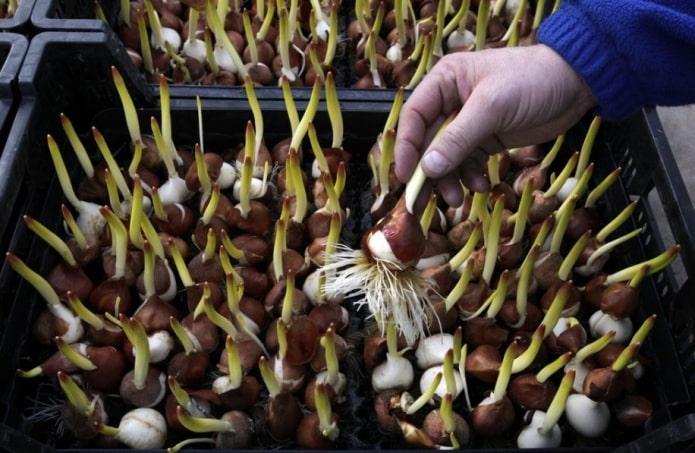
Plant the bulbs correctly
Tulips are usually grown in pots with drainage holes in the bottom in winter. A standard ceramic container with a diameter of 15 cm will become a cozy container for three bulbs, equidistant from each other by 3 cm.
It is better to plant the prepared material in a special substrate sold in garden stores, but you can also make it yourself from 2 parts fertile soil, 2 parts humus and 1 part river sand. The optimum soil acidity for tulips is 6-7 pH.
Planting procedure:
- Pour drainage (crushed stone, perlite, vermiculite) into the pot to a height of 2 cm.
- Add substrate to the container by 2/3.
- Place the bulbs and dig in so that after carefully pressing the soil, they stick out from it by 1-2 cm.
- Cover with a paper cap or plastic cup.
- Water lightly with pink infusion of manganese.
You can force tulips in winter by placing the bulbs in tall glass containers with water so that the bottoms of the bulbs are 2-3 mm higher and constantly adding water, or by using drainage and hydrogel.
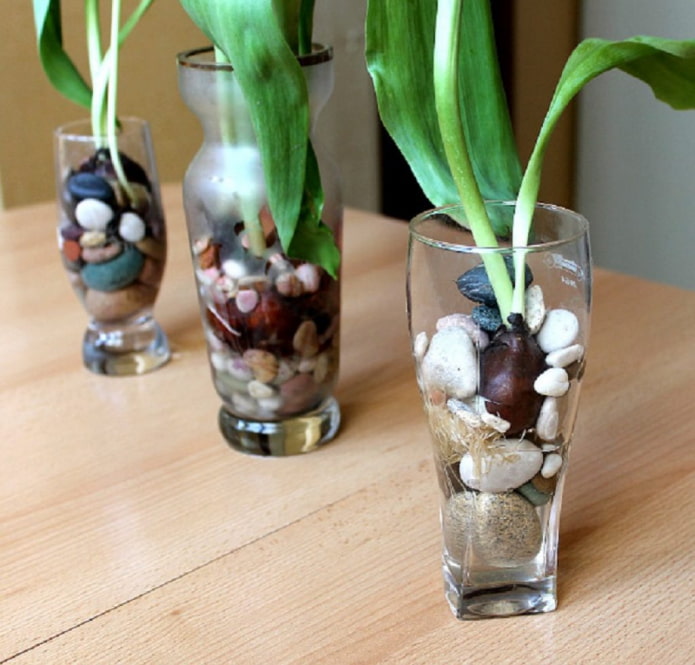
Provide the right conditions
The essence of forcing is that the plant consistently goes through the dormant and vegetative stages in a rooted mode. To do this, the environment should tell the tulip: it’s winter now, you need to sleep, but spring has come, it’s time to wake up, put out leaves and bloom.
After planting, you should immediately start “fooling” the bulbs. If you have few tulips, not for sale, but for personal joy, put them on the bottom shelf of the refrigerator. It is more convenient to organize a large-scale winter incubator in a basement or cellar. The main thing is that the place is dark, humid (80-85%) and cool (4-9 degrees). The flowers will “winter” for 6-8 weeks. During this time, they need to be moderately but regularly watered and fed with liquid mineral fertilizer for bulbous crops.
As it happens in nature, spring weather will not set in immediately. The pets will move to the balcony or a cold veranda (10-14 degrees) and at first will see the sun for 6 hours a day, and then the daylight hours will gradually increase to 10-12 hours. If you cannot achieve this naturally, it is better to get a phytolamp. “Spring” will last 4-6 weeks, after which the tulips will lose their caps, reach a height of 12-16 cm, release flower stalks and get ready to captivate with their beauty.
You need to put the sprouts on a warm (15-20 degrees), well-lit windowsill on the south or east side 2-4 weeks before the expected flowering date, which, like other dates, depends on the variety.
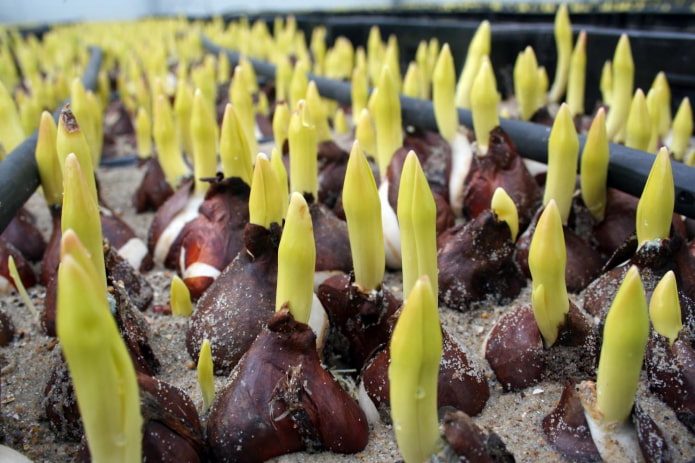
Follow the forcing regime
If the plants are lagging in development during the cycle, they need to be carefully given warmth and light until they get on schedule, and also monitor the water balance. Dryness and over-watering of the soil or air can equally be responsible for failure.
It is neglect of the tulip maintenance regime that most often leads novice gardeners to mission failure.
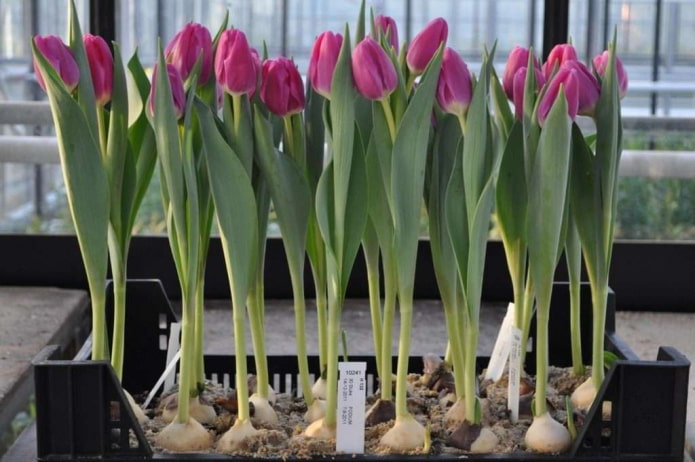
Discard illiquid stock
Unfortunately, the bulbs from which the flowers were obtained using hydroponics can no longer be dried, stored, or planted in the ground – they have exhausted their life resource. But the material used for forcing tulips in the ground may be suitable for further cultivation.
Having collected the long-awaited luxurious bouquet, dig up the bulbs, carefully examine and feel them, dispose of the unsightly and suspicious specimens, and prepare the promising ones for the next season.
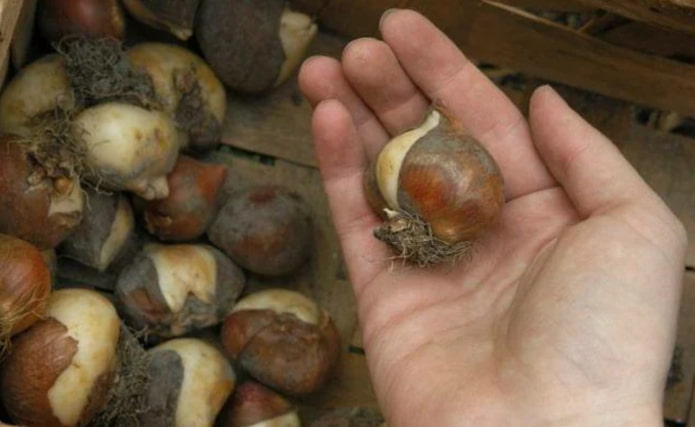
Growing tulips in winter is not at all difficult if you approach the task responsibly. But in this matter, the quality of the source materials is too important. If you are not sure of your reserves, contact the professionals.
Now reading:
- Brown sofa in the interior: 60 photos and ideas in light and dark shades
- BMW X5: Unleashing Ultimate Luxury and Performance
- 67 best interior solutions in blue tones: design photos for inspiration.
- Black floors in the interior: 70 photos, ideas, design and color combinations.
- Beige in the interior: stylish combinations and inspiring design ideas